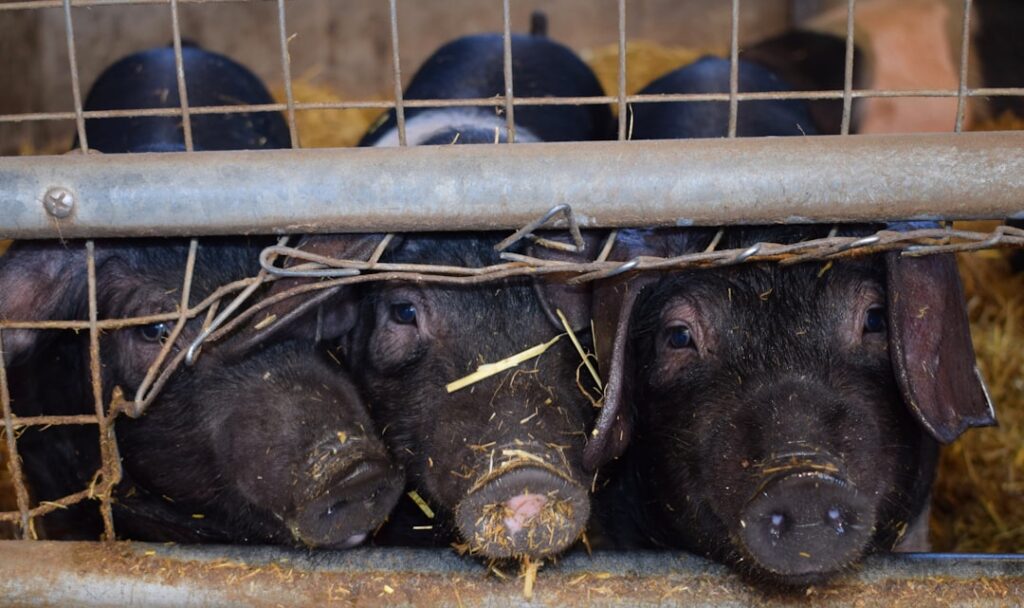Pig rearing is a popular and profitable venture for many farmers around the world. Pigs are known for their high reproductive rate, fast growth, and ability to convert feed into meat efficiently. Before starting a pig rearing business, it is important to understand the basics of pig rearing. Pigs are social animals and thrive in groups, so it is recommended to keep them in pairs or small groups to prevent stress and aggression. They also require a clean and comfortable living environment, regular feeding, and proper healthcare to ensure their well-being.
Pigs are omnivorous animals and can eat a wide variety of foods including grains, vegetables, fruits, and even meat. They require a balanced diet that provides all the essential nutrients for growth and development. Additionally, pigs need access to clean water at all times to stay hydrated and maintain their health. Proper housing, feeding, and healthcare are essential for successful pig rearing. It is also important to consider the breed of pigs that will be reared, as different breeds have different characteristics and requirements. Overall, pig rearing can be a rewarding venture when done correctly, providing a good source of income and meat for the farmer.
Key Takeaways
- Pig rearing requires proper housing, feeding, and health management for successful farming.
- Choosing the right breed of pig is crucial for the success of your farm and should be based on your specific needs and goals.
- Adequate housing and space are essential for the well-being and productivity of pigs.
- Proper nutrition and feeding practices are necessary for maintaining healthy and productive pigs.
- Effective disease management and regular health checks are crucial for the overall well-being of the pigs and the success of the farm.
Choosing the Right Breed for Your Farm
When it comes to pig rearing, choosing the right breed is crucial for the success of the business. There are many different pig breeds available, each with its own unique characteristics and suitability for specific farming conditions. Some popular pig breeds for rearing include the Duroc, Hampshire, Yorkshire, and Landrace. These breeds are known for their fast growth rate, high meat quality, and adaptability to various farming environments. It is important to consider factors such as climate, available resources, market demand, and farming goals when selecting a breed for pig rearing.
For example, if the farm is located in a hot climate, it may be beneficial to choose a breed that is heat-tolerant and has a good feed conversion rate. On the other hand, if the goal is to produce high-quality pork for the market, selecting a breed known for its meat quality and marbling would be ideal. Additionally, some pig breeds are better suited for small-scale farming, while others are more suitable for large commercial operations. It is important to research and consult with experienced farmers or agricultural experts to determine the best breed for the specific farming conditions and goals.
Housing and Space Requirements for Pigs
Proper housing and space requirements are essential for the health and well-being of pigs. Pigs require a clean and comfortable living environment that provides protection from harsh weather conditions, predators, and diseases. When designing a pig housing facility, it is important to consider factors such as ventilation, insulation, flooring, and drainage to ensure optimal living conditions for the animals. The housing should also be spacious enough to allow pigs to move around freely and engage in natural behaviors such as rooting and nesting.
The space requirements for pigs will vary depending on factors such as the breed, age, size, and number of pigs being reared. As a general guideline, each pig should have at least 8-10 square feet of space in the housing facility. It is important to provide separate areas for feeding, resting, and waste disposal to maintain cleanliness and prevent stress-related behaviors. Additionally, proper fencing and gating should be in place to ensure the safety and security of the pigs. Overall, providing adequate housing and space for pigs is essential for their health, productivity, and overall well-being.
Feeding and Nutrition for Healthy Pigs
| Feeding and Nutrition for Healthy Pigs | Recommended Metrics |
|---|---|
| Body Weight | 20-25 kg at 8 weeks, 90-100 kg at 22 weeks |
| Daily Feed Intake | 2-2.5% of body weight |
| Protein Content | 16-18% in starter feed, 14-16% in grower feed |
| Energy Content | 3200-3400 kcal/kg in starter feed, 3000-3200 kcal/kg in grower feed |
| Vitamin and Mineral Supplements | Ensure adequate levels of vitamins A, D, E, and minerals like calcium and phosphorus |
Feeding and nutrition play a critical role in the health and growth of pigs. Pigs are omnivorous animals with a high metabolism, so they require a balanced diet that provides all the essential nutrients for growth and development. A typical pig diet consists of grains such as corn, wheat, and barley, along with protein sources such as soybean meal, fish meal, or meat by-products. Additionally, pigs can be fed with fruits, vegetables, and other agricultural by-products to supplement their diet.
It is important to provide pigs with clean and fresh water at all times to ensure proper hydration and digestion. The feeding schedule should be consistent and regular to prevent overeating or underfeeding. Overfeeding can lead to obesity and health problems, while underfeeding can result in stunted growth and poor productivity. It is also important to monitor the body condition of the pigs regularly to adjust their diet as needed. Working with a veterinarian or animal nutritionist can help develop a feeding program that meets the specific nutritional needs of the pigs based on their age, weight, and breeding status.
Health and Disease Management
Maintaining the health of pigs is crucial for the success of a pig rearing business. Pigs are susceptible to various diseases such as swine fever, foot-and-mouth disease, respiratory infections, and parasitic infestations. It is important to implement a comprehensive health management program that includes vaccination, biosecurity measures, regular health checks, and proper sanitation practices. Vaccination against common diseases such as swine fever, porcine reproductive and respiratory syndrome (PRRS), and erysipelas can help prevent outbreaks and reduce the risk of disease transmission within the herd.
Biosecurity measures such as controlling access to the farm, quarantining new animals, and disinfecting equipment can help prevent the introduction and spread of diseases. Regular health checks by a veterinarian can help identify any signs of illness or infection early on and provide timely treatment. Additionally, maintaining a clean living environment with proper waste management practices can help reduce the risk of parasitic infestations and bacterial contamination. Overall, proactive health management is essential for ensuring the well-being of pigs and minimizing the risk of disease outbreaks on the farm.
Breeding and Reproduction

Breeding and reproduction are important aspects of pig rearing that directly impact the productivity and profitability of the business. Pigs are known for their high reproductive rate, with sows capable of producing large litters multiple times a year. It is important to select healthy breeding stock with good genetics to ensure strong offspring with desirable traits such as fast growth rate, high meat quality, and disease resistance. Breeding stock should be regularly evaluated for reproductive performance, conformation, and overall health to maintain high breeding standards.
The reproductive cycle of pigs should be carefully managed to optimize fertility and litter size. Sows should be bred at the right age and weight to ensure successful pregnancies and healthy litters. Proper nutrition and healthcare are essential during gestation to support the health of the sow and developing fetuses. Additionally, it is important to provide a comfortable and stress-free environment for farrowing to ensure the well-being of both the sow and piglets. Working with an experienced swine reproductive specialist can help develop a breeding program that maximizes reproductive efficiency and genetic improvement within the herd.
Marketing and Selling Pigs
Marketing and selling pigs is an important aspect of running a successful pig rearing business. It is important to identify potential markets for pork products such as local butcher shops, restaurants, supermarkets, or direct-to-consumer sales. Developing strong relationships with buyers and understanding their specific requirements can help tailor production to meet market demand effectively. Additionally, branding and promoting the quality of pork products can help differentiate them from competitors in the market.
When selling pigs, it is important to consider factors such as pricing, transportation logistics, packaging, and compliance with food safety regulations. Developing a marketing plan that includes strategies for product promotion, distribution channels, and customer engagement can help maximize sales opportunities. It is also important to stay informed about market trends, consumer preferences, and industry regulations to make informed decisions about product positioning and sales strategies. Overall, effective marketing and selling practices are essential for maximizing profitability and ensuring the success of a pig rearing business.
In conclusion, pig rearing can be a rewarding venture when done correctly with proper knowledge about breeding stock selection, housing requirements feeding practices among others . By understanding the basics of pig rearing , choosing the right breed , providing adequate housing , proper feeding , healthcare , disease management , breeding , reproduction , marketing , selling practices , farmers can ensure the success of their pig rearing business while providing high-quality pork products to consumers around the world .
Check out this insightful article on pig farming and sustainable agriculture at Future Driven Mom. Learn about the innovative practices and technologies that are shaping the future of pig farming and how it contributes to sustainable agriculture. Discover how modern pig farming methods are not only improving efficiency but also reducing environmental impact, making it an essential read for anyone interested in the future of food production.
FAQs
What is pig11?
pig11 is a programming language and platform for analyzing large data sets. It is often used in conjunction with Apache Hadoop for processing and analyzing big data.
What are the key features of pig11?
Some key features of pig11 include its ability to handle complex data types, its support for user-defined functions, and its optimization techniques for processing large data sets.
How is pig11 different from other programming languages?
pig11 is different from traditional programming languages in that it is specifically designed for processing and analyzing big data. It provides a high-level language for expressing data analysis programs, making it easier to work with large data sets.
What are some common use cases for pig11?
pig11 is commonly used for tasks such as data cleaning, exploratory data analysis, and data transformation. It is often used in data processing pipelines for tasks such as log analysis, data warehousing, and predictive modeling.
Is pig11 suitable for all types of data analysis tasks?
While pig11 is well-suited for many data analysis tasks, it may not be the best choice for all scenarios. For example, tasks that require real-time processing or complex machine learning algorithms may be better suited for other tools or programming languages.
How can I learn pig11?
There are many resources available for learning pig11, including online tutorials, documentation, and training courses. Additionally, practicing with real-world data sets and working on projects can help solidify your understanding of pig11.






